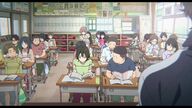"The Shape of Sound", which has recently been screened in China, is a phenomenon-level animation comparable to "Your Name". It not only won a bunch of awards, but also broke the box office record of Kyoto Animation.
Xin Haicheng also tweeted to praise this work:
"I watched the trial screening of "The Shape of Sound". This is a great work. There are serious and meticulous ideas everywhere, and the paintings, colors and emotions are all beautifully presented.
The elegant performance is something that others can't imitate. The dubbing guys are also very good. I personally was shocked by the free performance of entering the wild. I really like it. "
It is worth noting that because the film involves bullying and hearing impaired themes, the Japanese Ministry of Education, Culture, Sports, Science and Technology decided to promote "Shape of Voice" to elementary and middle school students. The purpose is to prevent bullying and suicide in schools and to popularize the understanding of people with disabilities.
Why is "Shape of Sound" so powerful? This is due to the production company behind it- Kyoto Animation .
Anime fans should have heard this sentence: " Kyoani produces, must be a boutique ", Kyoani refers to Kyoto Animation, which was established in 1981, and started from outsourcing work. In 2003, Kyoto Animation was established to start independent animation production. .
A few years later, he became famous for his "The Melancholy of Haruhi Suzumiya", one after another of phenomenal masterpieces, from "Sound Girl" to "CLANNAD". Even viewers who are not familiar with anime may be interested in them. The works have been heard.
In addition to high-level animation production, Jing Ani is best at producing emotional and delicate plots, which allows Jing Ani to maintain a super high standard in the control of the campus youth love theme.
"The Shape of Sound" continues the advantages of previous works, as always in performances and paintings, and the grasp of details is also in place. This makes the whole work look beautiful and romantic, and the style alone conquered the audience.
Regardless of the awesome background blessings, the theme of "The Shape of Voice" is also very special. The heroine is a hearing impaired, and therefore becomes a victim of school violence.
This setting has made "Shape of the Voice" win wider attention. The theme of adolescent emotions is very common in Japanese dramas and Japanese comics, while the themes of bullying and disability are relatively rare.
After reading it, think about it carefully, the well-known "Shape of Sound" actually has many problems.
The director's ambition is not small. She wants to explore many issues in the film: hearing impaired, campus bullying, redemption, single-parent families, etc., with many related characters, trying to pack these into a two-hour movie with strong production capabilities. middle.
The director wanted to present all the content, but ignored the plot and concept of the movie. This is the flaw of "Shape of Sound".
The description of bullying in the film restores to a certain extent the real situation of school violence in Japan.
Generally speaking, the attitude of ordinary people towards bullying is divided into several levels. This is the status quo at the beginning of the film. In order to protect the immature flowers of the motherland, all the scenes of school violence were deleted when it was released in China.
The male protagonist and the second female are the executors of bullying. They directly committed violence to the female protagonist. For example, they dragged down the female protagonist’s hearing aid to play games, threw the notebook she used for communication into the pool, and they led other people. All began to reject the heroine.
The third female is a non-playing participant. On the surface, she seems kind, but she secretly speaks ill of the heroine, secretly making things worse.
More classmates are bystanders. Like most ordinary people, they are indifferent to the campus violence that is happening in front of them.
The hostess was rejected, on the one hand, because as a hearing impaired, it was difficult to communicate with her classmates.
Secondly, the teacher wants students to spend some time every day to learn sign language, but most students don't want to learn it.
In addition, the performance of the heroine in the choir dragged everyone down. Over time, the heroine becomes an outlier who destroys the collective harmony.
On the other hand, this is also related to the heroine's character. The physical disability makes her feel a deep sense of inferiority. She will only habitually apologize and take things to herself.
The male protagonist couldn't understand this kind of excessive kindness, so he bullied her more and more.
Here are the routines of Japanese movies that I hate the most. The heroine did nothing wrong but attributed the fault to herself. On the contrary, the bullies made all the excuses.
No matter what the excuse is, hurting is hurting. Is it reasonable to bully?
Since there are so many troubles in ordinary schools, why didn't the female lead go to the school for the deaf in the first place?
If you are surrounded by people like yourself, can you avoid bullying?
Here we have to mention the heroine's mother. The heroine's mother is a strong-character mother. She has high expectations for the heroine and hopes that her daughter can grow into a normal person through hard work.
It is also the mother's intention to let the female lead go to ordinary elementary school. This expectation is based on the mother's love for her daughter. Regrettably, the hostess did not grow up smoothly as she expected.
The hostess really tried very hard to integrate into the new school, but because of communication barriers and cowardly personality, this effort did not allow her to be treated like a normal person, but she was bullied.
After the female protagonist fell in love with the male protagonist, she tried to confess to the male protagonist in a normal way. Not only was she misunderstood, she was said to be "very weird".
Although the male protagonist is unintentional, this endless cycle of constant efforts and constant blows made her suspect that she was born an alien, so when faced with any problems, the female protagonist would only blame herself.
In the end, the heroine came to a very terrible conclusion: her own existence will make people around him suffer misfortune.
When the children are still very young, bullying may not be malicious, and this is also the most terrifying place.
Those bullies and onlookers may not know what they have done wrong, but the harm they have caused to others is cruel and profound.
The cause of campus violence is largely caused by the atmosphere. No one is innocent in this atmosphere. Everyone is a participant in campus violence.
When the male protagonist himself became the bullied, he realized how serious he had committed against the female protagonist.
This young man, who could not find a place in the world, was willing to try to make up for his previous mistakes. It was a very courageous thing.
The director also gave back this courage, and the male protagonist gradually accepted himself in the path of atonement and self-salvation.
However, the problem with the film lies here.
The male protagonist’s problem was solved, but the more serious female protagonist’s problem was shelved.
The fundamental problem of the female protagonist is the severe inferiority complex caused by the hearing impairment, so she will say "I don't like myself."
The film’s solution to the problem is to let the heroine tell the heroine that he needs her, giving the heroine a reason to continue living. But can this kind of survival meaning dependent on the needs of others last forever?
What if the heroine no longer needs the heroine in the future? Is the value of a heroine just being needed by someone?
It is not difficult to see that the heroine has many advantages, gentle and sincere, hardworking and intelligent.
Why did no one tell the hostess from beginning to end that she did nothing wrong, she is a good child, and she should truly like and accept herself from the heart.
As an important heroine, this role was a failure, and her existence became a prop to promote the development of the plot.
When the male protagonist needed to find a chance to contact the female protagonist again, he met the female protagonist in the sign language class. When the male protagonist needs to complete the atonement, the story arranges the female protagonist to commit suicide to let him save.
There are only a few descriptions of the heroine's heart in the film, making the audience's impression of the heroine only gentle and pitiful. As a member of a special group, her struggles and breakthroughs were ignored consciously or unconsciously.
Setting up such a heroine without personal will to boost the hero's self-salvation is actually a misunderstanding of "salvation".
The movie "Swiss Army Knife Man" is a good example: the male protagonist Hank lost his mother since he was a child, has a withdrawn personality, and was even regarded by his father as mentally retarded.
Hank, who was not accepted by the society, wanted to end his life, but when he committed suicide, he encountered a corpse who could fart and talk.
With the help of the corpse, he came to an isolated island on the sea, and built their small world with the corpse on the isolated island.
The absurd plot implies that the corpse is actually the inner mirror image of Hank's self-split. He confessed to the corpse again and again, in fact, reconciling with his inner heart.
At the end of the story, Hanke returns to human society. Although the reality is still cruel, Hanke is still a weird man in the eyes of people, but he has been able to accept his shortcomings, calmly face the ridicule and questioning of everyone, and is no longer trapped in the outside world. Of bondage.
"Swiss Army Knife Man" looks very magical, but the truth it tells is true and straightforward: whether you can complete self-salvation, you should not expect power from elsewhere, all the motivation comes from the boiling of your heart.
Going back to "The Shape of Sound", in a film with a hearing impaired theme, the production team did not give this group a chance to speak out. To some extent, this is a disrespect for the theme.
The ending of "Shape of Sound" is indeed teary under the background of the screen and BGM, but it is also inexplicable.
Because no matter what happens, bullying is a black spot that cannot be washed away, and most of the perpetrators did not apologize at all and did not realize their fault.
Under this premise, arranging for the victim and the perpetrator to reconcile forcibly is just wishful thinking of the director and production team.
And the female protagonist who suffered the most from the beginning to the end has never forgotten her. This kind of Japanese romantic reconciliation cannot be accepted and understood by many people.
In particular, the whole article is trying to find excuses and reasons for the bully, trying to give the bully an explanation for the normalization of behavior. It seems that as long as the reason is sufficient, the harm of the behavior can be forgiven? My backhand is an Italian cannon!
The director said in the interview that he did not want to make campus violence too sensational, and deliberately played down the evil consequences of bullying.
But after all, movies are also guiding, especially for such a special themed movie promoted to Japanese elementary and middle school students, and the social impact of the movie should be carefully considered.
If you can show the living conditions of these special people, analyze the reasons for the plight, and try to give some solutions, it may be more meaningful than a youth entertainment film with "bullying" and "hearing impaired" as gimmicks.
In the face of serious social themes, it is more valuable to face the problem squarely than to avoid reality. The director hopes to make campus violence less sensational, but ignores the seriousness of the problem itself.
Once a movie is released, it will be oriented, and facing the problem squarely can reflect this meaning more than downplaying bullying.
So instead, we hope that the atmosphere of "Shape of Voice" can be more real. After all, romanticizing school violence can't solve any problems.
The movie is called "The Shape of Voice". Unfortunately, we haven't been able to see the true shape of the heroine's inner voice.
View more about A Silent Voice: The Movie reviews











